Genre: Action Developer: Dinamic & Zeus Software Publisher: Electronic Arts Players: 1 Released: 1992
Electronic Arts. Back in the early Genesis days, this company that now seems to engulf smaller companies on a monthly basis was itself a bit of an outsider. A small third party that was just getting its feet wet in the console world. Among the games EA released, a healthy group of them were basically ports of PC games. Some made the journey better than others, and of those ports, a few of them were action platformers. One such game was called Risky Woods, which came out for the Amiga, PC and Genesis in 1992. But the question is, can the Genesis version hold a candle to its computer cousins, or is it the relative no one likes to talk about? Read on.
The world at one time was a mostly peaceful place, with monks to help protect the people living there. However, the evil wizard Draxos has swept in, turning all the monks into statues, allowing evil to spread over the land. The dead now walk, and demons roam the land with them. The cries of the people are heard by a young warrior named Rohan, who takes it upon himself to set the monks free, best Draxon, and return the land to the way it had once been. But much stands in the way of our hero, and to complete his task, he must enter the Risky Woods, where Draxon and his army reside. Will he be able free the monks before any more ills befall the people?
When the game first starts, you’re struck right away by the visuals. They may not be the best the Genesis has to offer, but they’re undoubtedly nice. Colorful, with plenty of shading to be found on virtually everything, animations on the enemies and your character that are rather smooth (if a bit awkward at times), a somewhat cartoony visual style, and even a cool little effect that darkens things in some areas when you walk behind a big enough wall. There are also lots of little details on the objects and characters, as well as some interesting, and at times humorous designs (like the stoned-looking moth boss). The enemies aren’t necessarily numerous in terms of how many types there are, and some are really just redrawn versions of other enemies, but they’re handled well and look fine overall.
The backgrounds, like the characters, have colorful, well shaded and detailed appearances. There’s also a fair bit of parallax going on at times, helping to give the backgrounds a good sense of depth as you make your way through the levels. There are only four worlds, but there are eight backgrounds overall, with the two main levels of each world using the foreground to block much of the background in spots. Couple this with the relatively short nature of the levels, and the result is backgrounds that give the appearance of having more diversity than the numbers suggest. So basically, it’s a good-looking game, not the system’s best, but it shows that the folks who ported this to the Genesis put in some effort to retain the game’s visual qualities.
Aurally, Risky Woods is not too bad. The sound effects are decent, featuring explosions, weapons being thrown, spells being cast, and some voice samples. One must admit, that there really aren’t all that many (there are quite a few repeats in the sound test if you sift through it), and some are oddly quiet, but the ones that are there do the job fine. Musically, the game is pretty good. The songs have solid composition with synths that, while a bit harsh sounding at times (in that EA sound engine tradition), still go well with the catchy rhythms. You probably won’t be humming any of them as you go about your day (though some like “Mountines” and “Las Cavernas” stand out), but they’re enjoyable. The end product is a solid game in this area.
With the gameplay, you’ll go through twelve levels, encompassing four worlds, with a boss at the end of each world. For the two main levels, you’ll have four minutes to get through, while for the bosses, you have two minutes to beat them and exit the small arena. Along the way, you can grab a number of weapons, ranging from simple daggers and axes, to boomerangs and fire crescents. Each of these can be powered up twice, allowing you to cut through multiple enemies at once, and do more damage to the bigger enemies. The bosses start pretty simple but get tougher and a bit more complicated as you progress, but it always boils down to hitting the head/body to kill it. There are two to three monks to be freed on each regular level, and these guys fill the screen with enemy damaging energy when let loose (with some decoy monk statues that can hurt you). You’ll also find pits to fall into and spikes to avoid populating the levels, but hazards aren’t the only thing you’ll come across. There are treasure chests that drop various items from skulls (staff “bombs”) and invincibility, to apples, extra time, and the occasional continue. However, the game takes a little turn here.
Some of these items are basically traps. To be more specific, two of them are… the apples, and the arrows pointing to the left. Randomly, these items go back and forth between giving you points and having an effect on your character. For the apples, the effect basically has you fall asleep as the timer ticks away quickly while you regain some health. For the arrows, the effect sends you back a certain distance, making you re-fight areas and lose time (sometimes a short distance, other times a longer one). And for the oddest twist, you get you plat a bit of Simon. Yes, Simon. At certain points, there’s a statue that requires you to have collected both halves of a gate key (which looks a little like a golden wagon wheel). If you’ve done this, you release it and then have to press the D-pad in the pattern that plays in the statue to both gain some weapons and be able move forward. If you didn’t get both halves, then the statue sends you back to the piece you missed, and you have to journey back to the statue while losing more time.
Lastly, one of the quirkier traits is how you can power up your character armor-wise. When killed, some enemies release what looks like a coin that you can pick up by kneeling down on it. These are actually individual armor links. These things can also be found in occasional bags and urns that are released, which give you multiple links to pick up when destroyed. thirty-three links will give you silver armor, allowing you to take less damage. But sixty-seven links will give you gold armor for even better protection. However, every time you’re hit, you lose an armor link, and when you die, you lose a handful. The result is a constant battle to stockpile them so you can keep your armor.
So… what’s wrong with the pretty good picture that’s being painted thus far? Well, while various aspects of Risky Woods are solid, there are troublesome areas that stand out. Firstly, this game can be absolutely cheap when it comes to enemy hits. Some enemies can fire at you from off screen, and these enemies are usually up on a platform that makes it so you have to jump to hit them (you can’t fire up or at an angle). The problem is, if you get hit when jumping, you can no longer attack until you land on the ground. The flying enemies cause the same issue when they slam into you, preventing you from attacking other airborne and ground-based enemies… which can lead to some really cheap repeat hits. This can then quickly result in situations where you simply can’t avoid taking damage, making for some frustrating armor link losses and deaths.
Another issue is how this game can be brutally, almost unfairly hard at times, and painfully easy at others. Enemies respawn constantly, often in pairs. So it’s a steady barrage from the sides and above as you try to make progress. Airborne enemies also have a bad habit of getting directly above you, where you’re just SOL if they come down at you. Add in how ground and air-based enemies will pop up from the edge of the screen and charge you as you’re jumping over a pit or what have you, and the end result is maddening at times. However, on the flip side of that, getting the armor that’s supposed to be a real challenge can be accomplished easily by simply finding a good spot where enemies steadily respawn, squatting down, and firing away. If you time it right, each released armor link will come right to you, and you’ll have the silver armor in no time before the end of the first level. Granted, this doesn’t alleviate how the enemies will pick you out of the air, or overwhelm you with respawning insanity, but it does make getting damaged less a lot easier than the programmers likely intended.
On the more minor side, the controls and hit detection aren’t quite right. Neither is glaringly bad, but the controls feel a little mushy once in a while as you play (especially during a jump), not constantly but periodically. The hit detection comes off the same way. In one spot it seems fine, and then you’re hit by something that didn’t look like it should have hurt you. It’s rarely a case of the enemy being far away, but mostly that there was still a little space between you and what you were trying to avoid/kill, yet you get hit anyway. So it’s basically a bit of inconsistency without ever being horribly off. And lastly, this game has the odd habit of occasionally throwing weapons and items where you can’t get them, or even into pits in spots. Perhaps this is intentional, but it comes off more as a rather sloppy bit of design.
Finally, how does the Genesis version match up with the PC version? There are some pretty significant differences, really. The powering up system was changed quite a bit for the Genesis, as in the PC version, you collect coins and have to buy weapon power ups from a shop between levels. The backgrounds are quite different at times, and even your character was altered (namely, his outfit). The Simon puzzles and staff bombs aren’t in the PC version, and the music is much nicer on the PC thanks to the Adlib and MT-32 sound cards (the compositions are still the same though). The Genesis version has a noticeably faster frame rate, so it looks smoother in motion, and despite the graphical changes, the Genesis version still conveys the same sense of detail, design and such. Oh, and both versions have the same unfairly brutal and stupidly easy difficulty spikes and pits. There are a fair number of other differences, but suffice it to say, while playing similarly in some ways, they’re quite different in others.
So where does Risky Woods stand in the lineup of Genesis titles? It has a far bit going for it graphically, gameplay-wise, and even aurally to a lesser degree. But then some odd design (and redesign) choices get in the way, and the whole game begins to get dragged down. Heavy enemy respawning, loads of cheap hits and deaths, and strange difficulty curves mar what could have been a quality action platformer. That’s not to say that there isn’t a reasonably enjoyable game here with good traits, because there is if you can conquer its problematic areas. The thing is, those problematic areas are tough to overlook since they’re always there. So if you’ve got the patience, there’s a chance that you may find it to be an all right port… but be ready to do some swearing.
SCORE: 6 out of 10

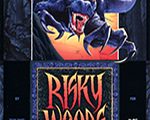
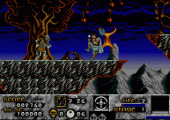
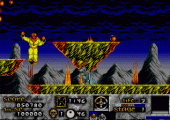
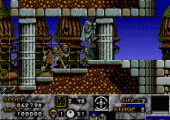
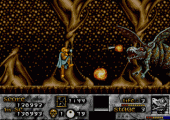
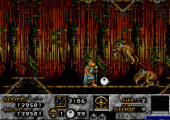
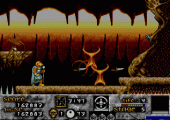
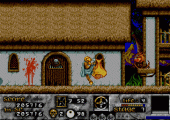
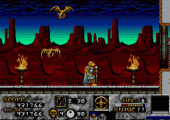
Recent Comments